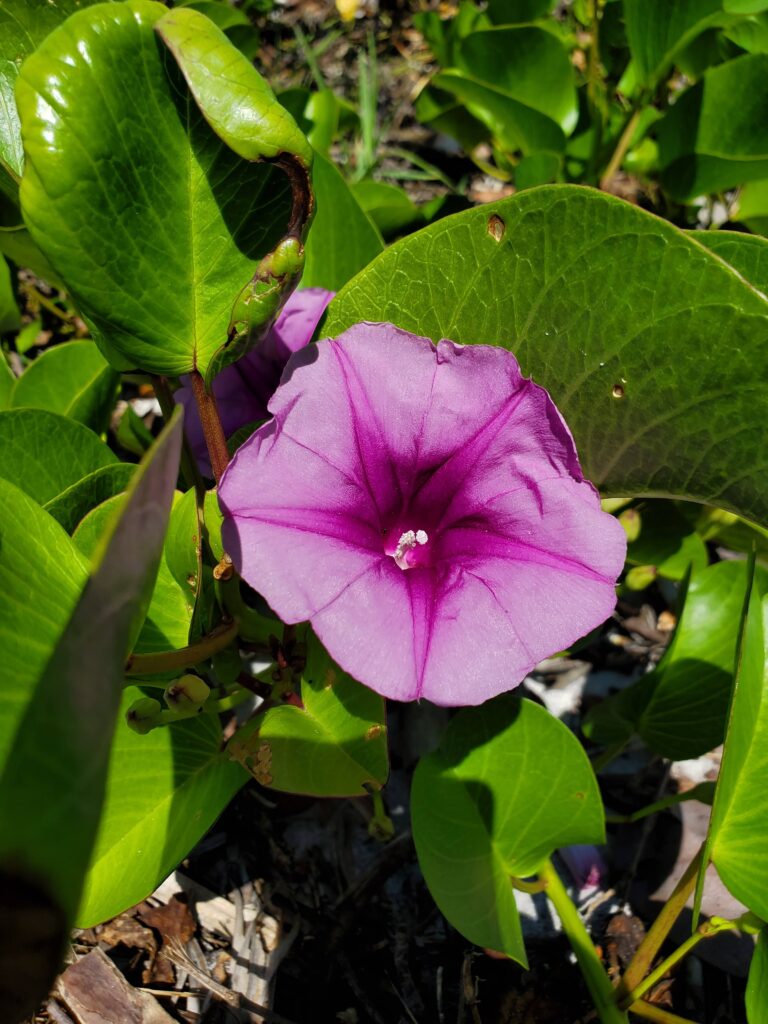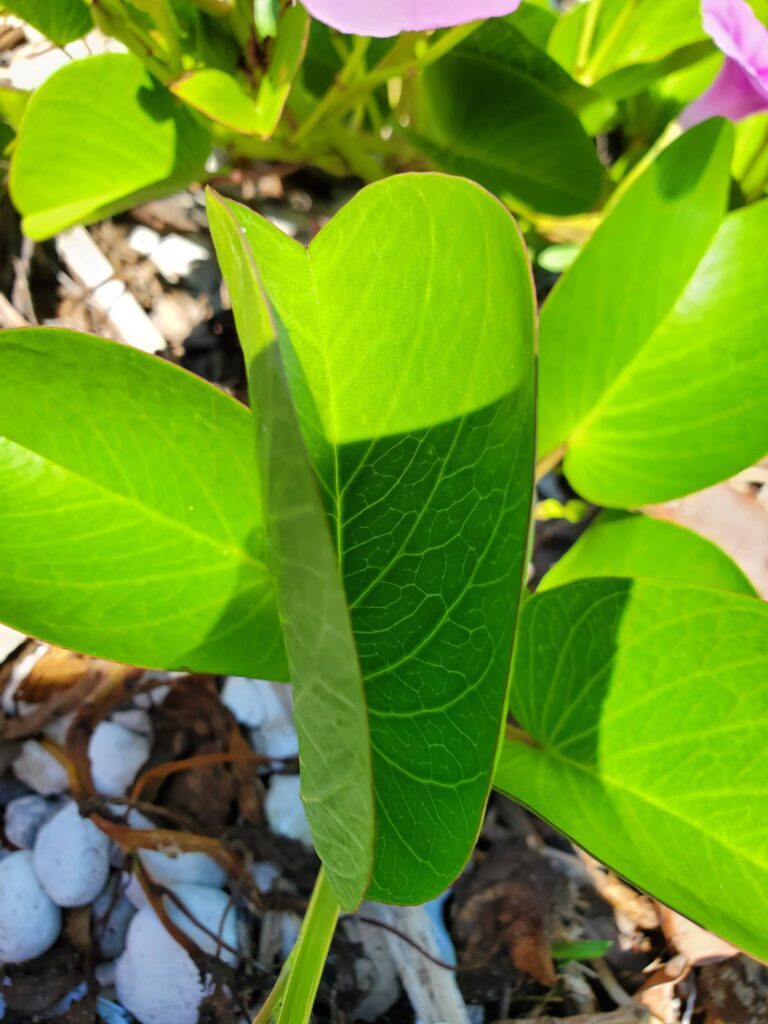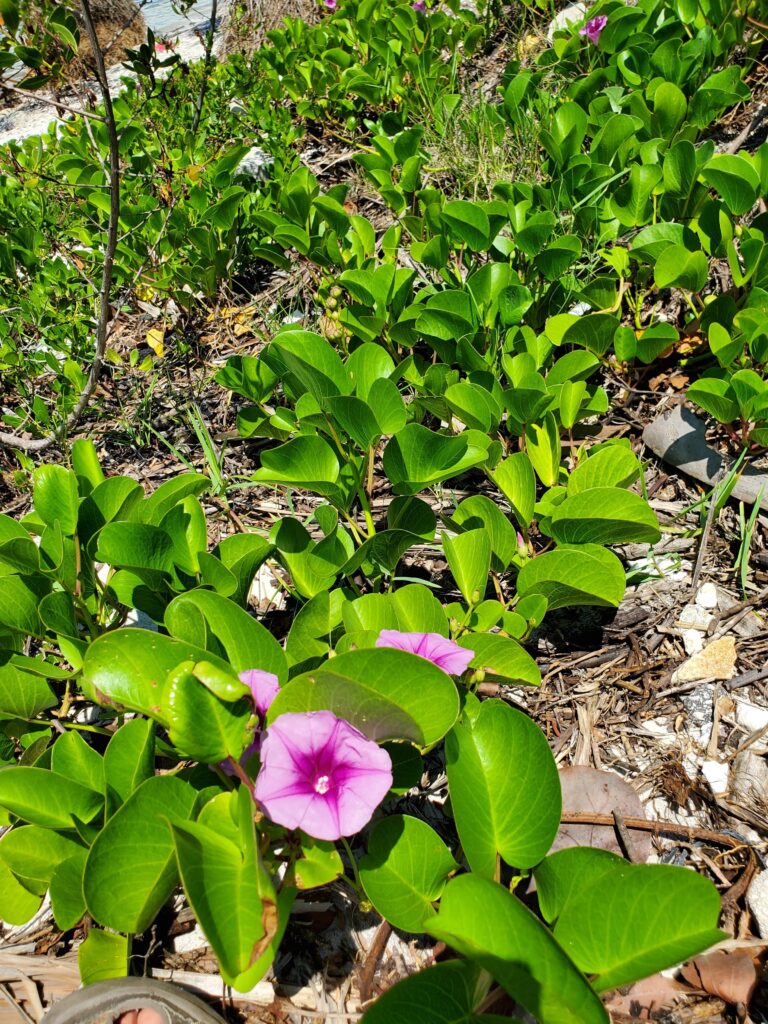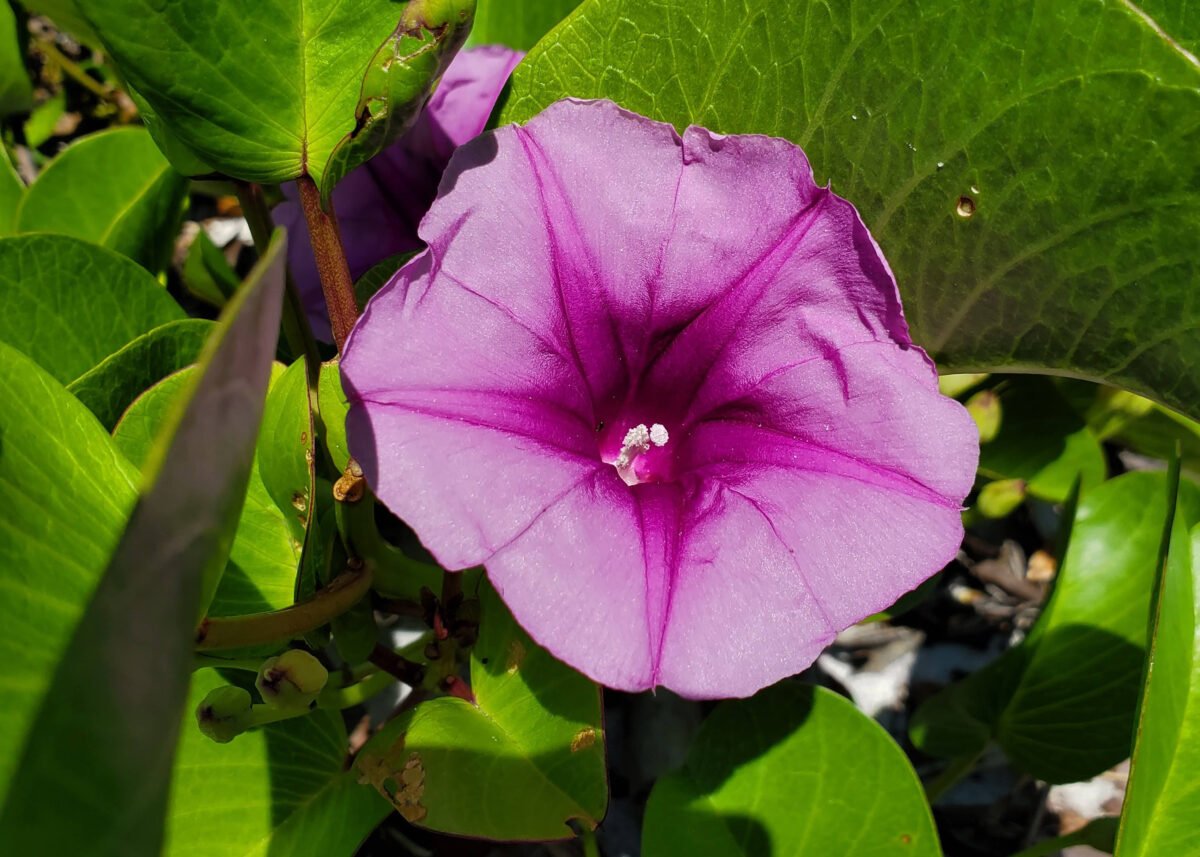Scientific name: Ipomoea pes-caprae
Other common names: Bayhops, Bay-hops, Beach Morning Glory, Goat’s Foot, or Railroad Vine. Hawaiian name, Pōhuehue. In Spanish, Bejuco de playa and riñonina. Tagalog name, Bagasua. Thai name, Phak bung thalé (ผักบุ้งทะเล).
Ipomoea pes-caprae shares the common name beach morning glory with another plant that grows in this area, ipomoea imperati.
Goat’s Foot is a pioneering sand stabilizer, being one of the first plants to grow on empty sand dunes. This means it protects beach sand from eroding and washing out into the ocean over time.
Identification



It’s scientific name, I. pes-caprae, comes from the Latin ‘pes’ for foot and ‘caprae’ for goat and refers to the resemblance of the outline of the leaf to the footprint of a goat 1. That is why one of it’s common names is Goat’s Foot. The leaves, which are thick, leathery and appear glossy, grow on vines and can be quite large. They are usually about at least the size of a medium sized human palm and bilobed (two lobes, like a hoof). They appear almost heart shaped and alternate. One of the plant’s claims to fame is that it can reach 100 feet long or more. Sturdy shoots form large mats close to the ground, behind the tide line, from underground root stocks.
The flowers resemble Morning Glory flowers. They are large, purplish pink, trumpet-shaped flowers. Each flower opens only once, in the morning, but they can keep coming almost all year long in Florida. The blooms are at their peak from May to November.
Growing/Foraging
Goat’s foot can be found naturally around most of Florida’s eastern shore.2 The plant will grow reasonably well from seed. When first planting, water for two weeks then only in times of prolonged drought. They are drought tolerant, prefer well drained soil, and are prone to funguses if overwatered. This is why they grow well in coral and in sandy shores, past the tide line. Goat’s foot is not shade tolerant and does require full sun. The plant spreads aggressively during its active growing period. It is recommended you trim it to confine it in a growing area. You can amend soil by adding cinder.
The vines of the plant can be prone to the following pests: sweet potato weevils, red spider mites, slugs, and snails. As aforementioned, overwatering can also lead to fungi. “Leaf spot disease” is caused by a fungus called Cercospora alabamensis. For symptoms and management please see the article “Leaf Spot of Beach Morning-Glory” provided by College of Tropical Agriculture and Human Resources and written by Nelson.
Sustainability
Goat’s Foot is extremely common and usually the only Morning Glory found along the eastern shore of Florida, literally on the beach. It is also common along the southeastern coast of the United States, Hawaii, the Caribbean, and eastern coasts of Central and South America. It’s reach is broad, and also includes east central Africa, west central Africa, India, Asia, and Australia.
Medicinal & Food Properties
Ipomoea pes-caprae is widely used in traditional medicine. It has been used in some parts of the world to treat fatigue, strain, arthritis and rheumatism. Some cultures also use it as a diuretic 3.
The plant is mucilaginous and is considered astringent, tonic, alterative, purgative, and, as aforementioned, diuretic. Poultices made from the leaves are commonly used to treat skin infections, ulcers, boils, swellings, stings and wounds. Decoctions are widely administered as anodyne, or painkiller, to treat rheumatism, and seeds against stomach-ache.
In west Africa leaf preparations are applied to ulcers and abscesses, as emollient and to treat arthritis, and in east Africa leaf pulp is used to treat rheumatism and colic.
In Madagascar root infusions are taken against syphilis, leaf infusions to treat urethral discharge and back pain, and leaf sap is taken against gonorrhoea.
In the Comoros leaf preparations are used as haemostatic, analgesic, cicatrisant and anodyne.
In Réunion a root decoction is administered against fever and colic.
In Indonesia root decoctions are considered emollient and used to diminish irritation caused by bladder infections.
Beach Morning Glory was also known by ancient cultures, like the Aztecs, for its pain relieving properties, and is becoming more popularly studied in the field of pharmacology for the treatment of painful processes. This is most likely due to its ability to inhibit the effects of molecules associated with localized pain, prostaglandins, in a bodily process called prostaglandin synthesis. For example, the cells that line uteruses, endometrial cells, create large amounts of prostaglandins. When those cells break down during menstruation (one’s period), the prostaglandins are released. They constrict the blood vessels in the uterus and make its muscle layer contract, causing what people with uteruses experience as painful cramps.
In Veracruz, México the seeds are considered medicinal 4. Medicinal uses are also reported in Nicaragua (febrifuge and laxative).
A subspecies, brasiliensis, is Native to Hawaii. There, a few of the young leaf buds (muʻo) are eaten by women just prior to giving birth to hasten delivery.5 The subspecies brasiliensis is known as salsa-da-praia in Brazil and used in traditional folk medicine. However, due to its cathartic compounds, it should be viewed as unsafe for internal use.
In a review by Marilena Meira 6: Goat’s foot has been shown to have effect in the treatment of inflammatory and analgesic processes 7. Heated leaves are used to treat wounds, skin infections, inamed sores and stings from poisonous jellyfishes, manta-ray and insects (Australian). Infusions have been recommended for treating hypertension, kidney ailments, and decoctions to treat digestive disorders, colic, internal and external pain, dysentery, inammations, fatigue, strain, arthritis, and rheumatism. The roots are used in diuretic disorders and in constipation (Pereda-Miranda et al., 2005; Lorenzi & Abreu Matos, 2002; Diaz, 1976; Martinez, 1989).
Goat’s foot is not great as a food. Its cooked roots, stems and leaves can be (and have been) eaten in small amounts as a famine food, however.
Spiritual Uses
In the Candomblé religion, the “father of saints” uses seeds and leaves of the Ipomoea species, such as, I. alba, I. pes-caprae and I. purpurea in the preparations that are offered to adepts of the religion, so they may attain a state of mind suitable for divination in their ceremonies. This is similar to historical practices of natives in Mexico 8.
Safety
More studies are necessary, but anecdotal data and oral traditions point to the plant’s parts being relatively safe externally and internally, in smaller doses. The same data indicates that the plant has diuretic and laxative properties, which makes large consumption undesirable in any case.
Recipes
Quick Jelly Fish Sting Treatment9
- Pick a few Goat’s foot leaves.
- Crush them using whatever tools you have at your disposal. If you don’t have anything you may use shells or rocks.
- Apply the paste to the affected area.
Sources

